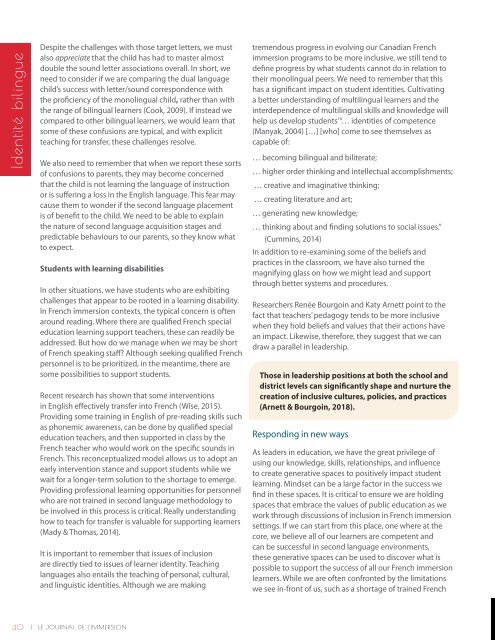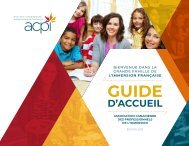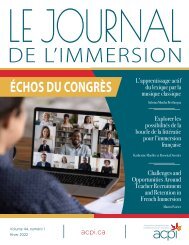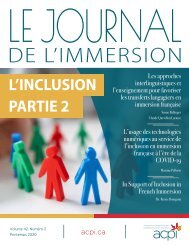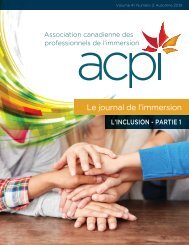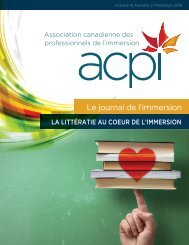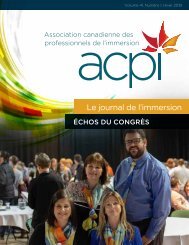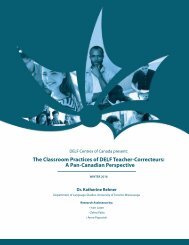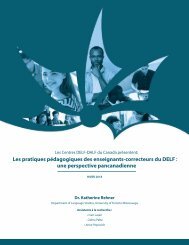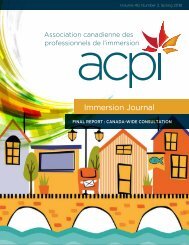Vol_43_n2_web_f
You also want an ePaper? Increase the reach of your titles
YUMPU automatically turns print PDFs into web optimized ePapers that Google loves.
Identité bilingue<br />
Identité bilingue<br />
Despite the challenges with those target letters, we must<br />
also appreciate that the child has had to master almost<br />
double the sound letter associations overall. In short, we<br />
need to consider if we are comparing the dual language<br />
child’s success with letter/sound correspondence with<br />
the proficiency of the monolingual child, rather than with<br />
the range of bilingual learners (Cook, 2009). If instead we<br />
compared to other bilingual learners, we would learn that<br />
some of these confusions are typical, and with explicit<br />
teaching for transfer, these challenges resolve.<br />
We also need to remember that when we report these sorts<br />
of confusions to parents, they may become concerned<br />
that the child is not learning the language of instruction<br />
or is suffering a loss in the English language. This fear may<br />
cause them to wonder if the second language placement<br />
is of benefit to the child. We need to be able to explain<br />
the nature of second language acquisition stages and<br />
predictable behaviours to our parents, so they know what<br />
to expect.<br />
Students with learning disabilities<br />
In other situations, we have students who are exhibiting<br />
challenges that appear to be rooted in a learning disability.<br />
In French immersion contexts, the typical concern is often<br />
around reading. Where there are qualified French special<br />
education learning support teachers, these can readily be<br />
addressed. But how do we manage when we may be short<br />
of French speaking staff? Although seeking qualified French<br />
personnel is to be prioritized, in the meantime, there are<br />
some possibilities to support students.<br />
Recent research has shown that some interventions<br />
in English effectively transfer into French (Wise, 2015).<br />
Providing some training in English of pre-reading skills such<br />
as phonemic awareness, can be done by qualified special<br />
education teachers, and then supported in class by the<br />
French teacher who would work on the specific sounds in<br />
French. This reconceptualized model allows us to adopt an<br />
early intervention stance and support students while we<br />
wait for a longer-term solution to the shortage to emerge.<br />
Providing professional learning opportunities for personnel<br />
who are not trained in second language methodology to<br />
be involved in this process is critical. Really understanding<br />
how to teach for transfer is valuable for supporting learners<br />
(Mady & Thomas, 2014).<br />
It is important to remember that issues of inclusion<br />
are directly tied to issues of learner identity. Teaching<br />
languages also entails the teaching of personal, cultural,<br />
and linguistic identities. Although we are making<br />
tremendous progress in evolving our Canadian French<br />
immersion programs to be more inclusive, we still tend to<br />
define progress by what students cannot do in relation to<br />
their monolingual peers. We need to remember that this<br />
has a significant impact on student identities. Cultivating<br />
a better understanding of multilingual learners and the<br />
interdependence of multilingual skills and knowledge will<br />
help us develop students’ “… identities of competence<br />
(Manyak, 2004) […] [who] come to see themselves as<br />
capable of:<br />
… becoming bilingual and biliterate;<br />
… higher order thinking and intellectual accomplishments;<br />
… creative and imaginative thinking;<br />
… creating literature and art;<br />
… generating new knowledge;<br />
… thinking about and finding solutions to social issues.”<br />
(Cummins, 2014)<br />
In addition to re-examining some of the beliefs and<br />
practices in the classroom, we have also turned the<br />
magnifying glass on how we might lead and support<br />
through better systems and procedures.<br />
Researchers Renée Bourgoin and Katy Arnett point to the<br />
fact that teachers’ pedagogy tends to be more inclusive<br />
when they hold beliefs and values that their actions have<br />
an impact. Likewise, therefore, they suggest that we can<br />
draw a parallel in leadership.<br />
Those in leadership positions at both the school and<br />
district levels can significantly shape and nurture the<br />
creation of inclusive cultures, policies, and practices<br />
(Arnett & Bourgoin, 2018).<br />
Responding in new ways<br />
As leaders in education, we have the great privilege of<br />
using our knowledge, skills, relationships, and influence<br />
to create generative spaces to positively impact student<br />
learning. Mindset can be a large factor in the success we<br />
find in these spaces. It is critical to ensure we are holding<br />
spaces that embrace the values of public education as we<br />
work through discussions of inclusion in French immersion<br />
settings. If we can start from this place, one where at the<br />
core, we believe all of our learners are competent and<br />
can be successful in second language environments,<br />
these generative spaces can be used to discover what is<br />
possible to support the success of all our French immersion<br />
learners. While we are often confronted by the limitations<br />
we see in-front of us, such as a shortage of trained French<br />
speaking learning support teachers, we are on a journey to<br />
ensure our students receive the supports necessary to be<br />
successful.<br />
Ongoing generative dialogues<br />
Supporting French immersion programs in a diverse urban<br />
centre presents unique challenges, many of which can be<br />
addressed through generative dialogue spaces that allow<br />
for both schools and different departments of the District to<br />
come together for a common purpose. Although we are still<br />
grappling with many of the challenges seen across Canada<br />
in French immersion programs, the systems of dialogue<br />
and collaboration we are establishing are putting us in a<br />
position to create possibilities in the face of challenge.<br />
Often, the challenges we are faced with as leaders are not<br />
easily or quickly solvable. To find solutions for the complex<br />
challenges we encounter, ongoing dialogue is critical to<br />
come to a place where we have the information to enact<br />
the appropriate supports, not only at a system level, but at<br />
the school level. This takes a genuine willingness to listen<br />
to the challenges being encountered in our classrooms, to<br />
deeply understand the matter at hand and determine the<br />
appropriate approaches to move us forward.<br />
Aside from hosting meetings throughout the year with<br />
our school leadership team, we are constantly engaging<br />
in dialogue with our French immersion school leaders<br />
to ascertain the answers to the evolving circumstances<br />
within our programs, as well as better understand what<br />
our students might be experiencing through Kaser and<br />
Halbert’s (2017) three big-picture questions:<br />
• What is going on for our learners?<br />
• How do we know?<br />
• Why does it matter?<br />
These guiding questions allow us to constantly reflect on<br />
what is working and what we might focus on for areas<br />
of growth. At the same time, we are working to ensure<br />
that current evidence-based practices are being brought<br />
forward to support our circumstances. Helen Timperley<br />
(2011) describes this work as leader knowledge building<br />
cycles, which are closely tied to ongoing and engaged<br />
professional learning at a school level. To face the<br />
challenges within, our leaders enact their roles in ways that<br />
focus on and achieve the outcomes valued for students,<br />
in this case success for all our French immersion learners<br />
(Timperley, 2011).<br />
40 | LE JOURNAL DE L'IMMERSION<br />
<strong>Vol</strong>. <strong>43</strong>, n o 2, été 2021 | 41


